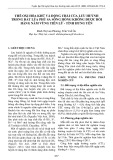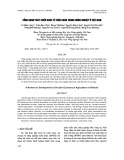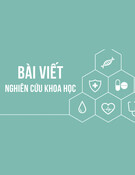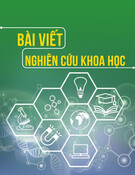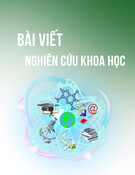
188 Nong Lam University, Ho Chi Minh City
The Journal of Agriculture and Development 23(Special issue 1) www.jad.hcmuaf.edu.vn
Modeling of fresh paddy aeration on transporting barges in Mekong Delta, Vietnam
Hieu V. Nguyen1, Duc A. Le2, & Nghi T. Nguyen2*
1Faculty of Engineering Technology, Tien Giang University, Vietnam
2Faculty of Engineering and Technology, Nong Lam University, Ho Chi Minh City, Vietnam
ARTICLE INFO ABSTRACT
Research Paper
Received: August 16, 2024
Revised: October 07, 2024
Accepted: October 10, 2024
Keywords
Aeration
Fresh paddy
Grain quality
Losses
Transporting barges
*Corresponding author
Nguyen Thanh Nghi
Email:
ntnghi@hcmuaf.edu.vn
The Mekong Delta is regarded as the granary of Vietnam, with
an annual production of 24.1 million tons (2023). Currently,
fresh paddy is transported directly from farmers’ fields to drying
facilities or rice mills. Given the extensive river and canal system
in the Mekong Delta, the majority of paddy (up to 92%) is
transported by barges. While barge transportation is more cost-
effective (91,000 VND/ton for a 100 km distance) compared
to truck transportation (269,000 VND/ton), it has significant
drawbacks, such as a longer transportation time of 3 to 5 days.
Moreover, because the paddy is wet during transport, it is prone
to discoloration (yellowing), which reduces its quality. To address
this issue, this research developed an experimental paddy aeration
model as a foundation for implementing aeration on barges during
transportation. The model was tested with 1.4 tons of fresh paddy,
specifically the DT80 variety, in Cai Lay, Tien Giang province. Key
parameters monitored and analyzed included paddy temperature,
moisture content, ambient conditions, and grain quality. The
model was tested with a specific airflow rate of 129±23m3/h per
ton. The paddy temperature in the aeration model was maintained
at 28.8°C, similar to the ambient temperature of 28.3°C. As a result,
the whiteness of the aerated paddy was preserved at 3.6% after three
days, whereas it decreased from 3.6% to 3.2% in paddy transported
without aeration. The application of aeration helped reduce quality
losses, particularly discoloration, caused by the high temperatures
of fresh paddy during transportation.
Cited as: Nguyen, H. V., Le, D. A., & Nguyen, N. T. (2024). Modeling of fresh paddy aeration
on transporting barges in Mekong Delta, Vietnam. The Journal of Agriculture and Development
23(Special issue 1), 188-195.

Nong Lam University, Ho Chi Minh City 189
The Journal of Agriculture and Development 23(Special issue 1) www.jad.hcmuaf.edu.vn
1. Introduction
Rice (Oryza sativa L.) is a major staple food
crop for half of the world’s population. With an
annual production of about 24.1 million tons in
2023, the Mekong Delta is considered the granary
of Vietnam. Unlike traditional practices, farmers
now sell their fresh paddy to traders immediately
after harvesting. The traders then transport the
paddy to rice mills for drying and processing.
Due to the Mekong Delta’s extensive river
system, paddy and other agricultural products
are primarily transported by barges (Nguyen et
al., 2015). In Long An province, for instance,
90% of fresh paddy is transported by barge
(Nguyen et al., 2019). However, this method has
disadvantages, including long transportation
times, which can lead to losses, particularly in
grain quality, due to discoloration caused by the
high temperature within the grain pile on barges.
Discoloration is triggered by fungi, bacteria, and
environmental conditions such as high humidity
and temperature (Gummert et al., 2020). The
higher the temperature of grains during storage
or transportation, the more intense the browning
reaction (Fatharani et al., 2022).
Aeration involves the forced movement of
ambient air through a grain bulk using fan power
to improve grain storability. This technique
is widely used in stored grain management
programs in the United States to modify the
microclimate within the grain bulk, reducing
or eliminating the development of harmful
organisms by lowering and stabilizing grain
temperatures (Navarro et al., 2012).
While aeration technology has been applied to
dry paddy in storage in Vietnam and other parts
of the world, there has been limited research on
its application to fresh paddy, particularly during
barge transportation after harvesting. To address
these research gaps, this study was conducted to
identify the parameters affecting grain quality
during barge transportation, complemented by
experiments using a model.
2. Materials and Methods
2.1. Survey on the status of paddy transport in
Mekong Delta
A survey was conducted in Tien Giang
province, where the experimental model
was installed, to assess the status of paddy
transportation. Data were collected using a
questionnaire, which included the ratio of paddy
transported by different types of transportation
(barges and trucks), transport costs, transport
duration, and the advantages and disadvantages
of each method. The sample size was determined
using the following formula (Yamane, 1967;
Israel, 1992):
Where: n is the number of samples (paddy
transport barges); N is the estimated total number
of paddy transport barges; and e is the estimated
error level. With the annual rice production of
24.1 million tons/year, the annual transport
capacity of barges of 1,000 tons/year, and the
expected accuracy level of 0.1, the number of
samples was computed at 99.6 (≈ 100) samples
for survey in Mekong Delta. For the first stage
of this study, a survey was conducted with 24
samples in the case of Tien Giang province with
a rice production of 765,000 ton/year.
2.2. Experimental model design
Based on the practical size of a barge used for
paddy transport, a model was designed for initial
experiments with the dimensions of the aeration
chamber of 2.5 m height (similar to the height
of the paddy pile on barges), 1 m width and 1
mlength (Figure 1).
2. Materials and Methods 63
2.1. Survey on the status of paddy transport in Mekong Delta 64
A survey was conducted in Tien Giang province, where the experimental model was 65
installed, to assess the status of paddy transportation. Data were collected using a 66
questionnaire, which included the ratio of paddy transported by different types of 67
transportation (barges and trucks), transport costs, transport duration, and the advantages and 68
disadvantages of each method. The sample size was determined using the following formula 69
(Yamane, 1967; Israel, 1992): 70
𝑛𝑛 = !
"#!$!
(1) 71
Where: n is the number of samples (paddy transport barges); N is the estimated total number 72
of paddy transport barges; and e is the estimated error level. With the annual rice production 73
of 24.1 million tons/year, the annual transport capacity of barges of 1,000 tons/year, and the 74
expected accuracy level of 0.1, the number of samples was computed at 99.6 (≈ 100) samples 75
for survey in Mekong Delta. For the first stage of this study, a survey was conducted with 76
24 samples in the case of Tien Giang province with a rice production of 765,000 ton/year. 77
2.2. Experimental model design 78
Based on the practical size of a barge used for paddy transport, a model was designed 79
for initial experiments with the dimensions of the aeration chamber of 2.5 m height (similar 80
to the height of the paddy pile on barges), 1 m width and 1 m length (Figure 1). 81
(1)

190 Nong Lam University, Ho Chi Minh City
The Journal of Agriculture and Development 23(Special issue 1) www.jad.hcmuaf.edu.vn
Figure 1. Experimental model (+ 3D) for fresh paddy aeration.
The model was loaded with 1.4 tons of fresh
paddy, a DT80 variety, in Cai Lay, Tien Giang
province. Inside the model, a set of sensors was
installed in layers to monitor the temperature
and humidity of the airflow, as well as the
temperature of the grains. During the test, the
parameters monitored included moisture content
(MC), temperature, and relative humidity (RH)
of the ambient air at the study site. The moisture
content of the grain was measured using a
moisture meter (Kett PM-600), and a digital
scale with an accuracy of 0.01 g was used for
weighing the paddy samples. Additionally, the
static pressure of the airflow through the grain
layer was measured and computed based on the
following equation.
Where: ΔP is the static pressure (Pa); h is the
height of the grain layer (m); and ΔP1 m is the
static pressure for each 1 m height of the grain
layer (Pa/m), which is computed as follows:
Where: V is the exit velocity of airflow (m/s); a
and b are coefficients (a = 25700 and b=13.2 for
paddy).
2.3. Grain quality tests
Grain quality assessment was conducted
based on criteria, such as head rice recovery
(HRR), discoloration, whiteness percentage and
amylose content. HRR was measured on milled
rice and calculated using the following equation:
Discoloration: This parameter was assessed
based on the transparency which was measured
using a milling meter (MM1D), with a range of
0.01 - 8.00%. The meter was also used to measure
the whiteness and milling degree.
Figure 1. Experimental model (+ 3D) for fresh paddy aeration.
The model was loaded with 1.4 tons of fresh paddy, a DT80 variety, in Cai Lay, Tien 82
Giang province. Inside the model, a set of sensors was installed in layers to monitor the 83
temperature and humidity of the airflow, as well as the temperature of the grains. During the 84
test, the parameters monitored included moisture content (MC), temperature, and relative 85
humidity (RH) of the ambient air at the study site. The moisture content of the grain was 86
measured using a moisture meter (Kett PM-600), and a digital scale with an accuracy of 0.01 87
g was used for weighing the paddy samples. Additionally, the static pressure of the airflow 88
through the grain layer was measured and computed based on the following equation: 89
𝑃𝑃 = 𝑃𝑃
"% ∗ ℎ (1) 90
Where: ΔP is the static pressure (Pa); h is the height of the grain layer (m); and ΔP1 m is 91
the static pressure for each 1 m height of the grain layer (Pa/m), which is computed as 92
follows: 93
𝑃𝑃
"% ='∗)!
*+("#-∗))
(2) 94
Where: V is the exit velocity of airflow (m/s); a and b are coefficients (a = 25700 and 95
b = 13.2 for paddy). 96
Figure 1. Experimental model (+ 3D) for fresh paddy aeration.
The model was loaded with 1.4 tons of fresh paddy, a DT80 variety, in Cai Lay, Tien 82
Giang province. Inside the model, a set of sensors was installed in layers to monitor the 83
temperature and humidity of the airflow, as well as the temperature of the grains. During the 84
test, the parameters monitored included moisture content (MC), temperature, and relative 85
humidity (RH) of the ambient air at the study site. The moisture content of the grain was 86
measured using a moisture meter (Kett PM-600), and a digital scale with an accuracy of 0.01 87
g was used for weighing the paddy samples. Additionally, the static pressure of the airflow 88
through the grain layer was measured and computed based on the following equation: 89
𝑃𝑃 = 𝑃𝑃
"% ∗ ℎ
(1) 90
Where: ΔP is the static pressure (Pa); h is the height of the grain layer (m); and ΔP1 m is 91
the static pressure for each 1 m height of the grain layer (Pa/m), which is computed as 92
follows: 93
𝑃𝑃
"% ='∗)!
*+("#-∗)) (2) 94
Where: V is the exit velocity of airflow (m/s); a and b are coefficients (a = 25700 and 95
b = 13.2 for paddy). 96
(1)
(2)
(2)
2.3. Grain quality tests 97
Grain quality assessment was conducted based on criteria, such as head rice recovery 98
(HRR), discoloration, whiteness percentage and amylose content. HRR was measured on 99
milled rice and calculated using the following equation: 100
𝐻𝐻𝐻𝐻𝐻𝐻, % = !"#$%&()*%(+"$,-#./
!"#$%&()0-112/-30+"/ 𝑥𝑥100 (2) 101
Discoloration: This parameter was assessed based on the transparency which was 102
measured using a milling meter (MM1D), with a range of 0.01 - 8.00%. The meter was also 103
used to measure the whiteness and milling degree. 104
3. Results and Discussion 105
3.1. Assessment of the status of fresh paddy transport in Mekong Delta 106
After harvesting, fresh paddy was transported from farmers’ fields directly to drying 107
farms' rice mills. With a multi-river and canal system in the Mekong Delta, most of the paddy 108
(up to 92%) was transported by barges (Figure 2), while the rest of that was transported by 109
trucks. 110
111
Figure 2. Barges for paddy transportation in Mekong Delta. 112
Transportation of paddy by barges was normally from 3 to 5 days for a distance of 113
100 - 200 km. It may take more time when the river is stuck by a dense layer of water 114
hyacinth. The long time of transporting, together with the wet paddy being transported, the 115
paddy is often yellowed, reducing its quality, and causing a loss in grain quality. Although 116

Nong Lam University, Ho Chi Minh City 191
The Journal of Agriculture and Development 23(Special issue 1) www.jad.hcmuaf.edu.vn
stuck by a dense layer of water hyacinth. The long
time of transporting, together with the wet paddy
being transported, the paddy is often yellowed,
reducing its quality, and causing a loss in grain
quality. Although transportation by truck takes
less time, its cost is much higher, and it is unable
to be applied in areas with a diverse river system
in Mekong Delta.
As a result, the costs were 91,000 and
269,000 VND/ton for 100 km transportation
by barges and trucks, respectively (Figure 3).
Similarly, in Mekong Delta, rice straw bales are
also mainly transported by barges and trucks. At
the same distance, the costs are 470,000VND/
ton/km and 564,000 VND/ton for 100 km
transporting straw bales by barges and trucks,
respectively (Nguyen et al., 2015).
3. Results and Discussion
3.1. Assessment of the status of fresh paddy
transport in Mekong Delta
After harvesting, fresh paddy was trans-
ported from farmers’ fields directly to drying
farms’ rice mills. With a multi-river and canal
system in the Mekong Delta, most of the paddy
(up to 92%) was transported by barges (Figure 2),
while the rest of that was transported by trucks.
Figure 2. Barges for paddy transportation in
Mekong Delta.
Transportation of paddy by barges was
normally from 3 to 5 days for a distance of 100 -
200km. It may take more time when the river is
Figure 3. Components of transportation cost.
transportation by truck takes less time, its cost is much higher, and it is unable to be applied 117
in areas with a diverse river system in Mekong Delta. 118
As a result, the costs were 91,000 and 269,000 VND/ton for 100 km transportation 119
by barges and trucks, respectively (Figure 3). Similarly, in Mekong Delta, rice straw bales 120
are also mainly transported by barges and trucks. At the same distance, the costs are 121
470,000 VND/ton/km and 564,000 VND/ton for 100 km transporting straw bales by barges 122
and trucks, respectively (Nguyen et al., 2015). 123
124
Figure 3. Components of transportation cost. 125
3.2. Testing results on the aeration model 126
Airflow rate for aeration: The airflow for aeration was supplied using a centrifugal 127
blower with a specific airflow rate of 129 m3/h per ton, corresponding to 2.2 m3/min per ton, 128
for the paddy layer of 2.5 m height in the model and the exit velocity of 3.2 m/s. According 129
to Ranalli et al. (2002), a specific airflow rate for aerating with a 7 m height was tested at 130
1.3 m3/min per ton, corresponding to an exit velocity of 4.3 m/s. However, it was 0.1 m3/min 131
per ton for the aeration of maize in a bin with a capacity of 597 tons (Maier, 1994). It meets 132
91,000
269,000
50 000
100 000
150 000
200 000
250 000
300 000
Depreciation
Interest
Fuel
Labor
Total
Transported by Barges
Transported by trucks
Cost, VND/ton (100 km)

192 Nong Lam University, Ho Chi Minh City
The Journal of Agriculture and Development 23(Special issue 1) www.jad.hcmuaf.edu.vn
uniform airflow distribution with the exit velocity
of less than 9m/min (Navarro et al., 2012).
Temperature: The temperature of paddy in
the model with aeration is 27.8°C, which is
lower than the ambient temperature of 30.4°C
on average. As shown in Figure 4, the bigger
difference in temperature between the grains
and ambient air was at noon. The reason for the
lower temperature of the grains was due to the
high temperature at noon while it is rather stable
for the grains which were cooled at night and in
the early morning.
3.2. Testing results on the aeration model
Airflow rate for aeration: The airflow for
aeration was supplied using a centrifugal blower
with a specific airflow rate of 129m3/h per ton,
corresponding to 2.2 m3/min per ton, for the
paddy layer of 2.5 m height in the model and
the exit velocity of 3.2m/s. According to Ranalli
et al. (2002), a specific airflow rate for aerating
with a 7 m height was tested at 1.3m3/min per
ton, corresponding to an exit velocity of 4.3
m/s. However, it was 0.1m3/min per ton for the
aeration of maize in a bin with a capacity of 597
tons (Maier, 1994). It meets the requirement for
Figure 4. Fluctuation of aeration air and grain temperature.
the requirement for uniform airflow distribution with the exit velocity of less than 9 m/min 133
(Navarro et al., 2012). 134
Temperature: The temperature of paddy in the model with aeration is 27.8°C, which 135
is lower than the ambient temperature of 30.4°C on average. As shown in Figure 4, the bigger 136
difference in temperature between the grains and ambient air was at noon. The reason for 137
the lower temperature of the grains was due to the high temperature at noon while it is rather 138
stable for the grains which were cooled at night and in the early morning. 139
140
Figure 4. Fluctuation of aeration air and grain temperature. 141
Grain moisture content: A small but significant drying effect (moisture loss per 142
aeration cooling cycle) was typically experienced. Although the main purpose of aeration 143
was to cool the bulk grain, the moisture content of the grain descreased by 3%, from 25.5 to 144
22.7%, after the 49 h of aeration. It is explained that the moisture content was reduced due 145
to the fundamentals of the moisture (H2O) was produced from the respiratory process of the 146
grain, which was removed from the grain pile during areation process. The data analysis 147
resulted in a regression equation as shown in Figure 5. In practice, the reduction rate depends 148
on the conditions of the ambient air around the model. As mentioned, the primary purpose 149
of aeration is to remove heat from the paddy pile and control the grain temperature to prevent 150
0
5
10
15
20
25
30
35
40
3/27/2024 9:36
3/27/2024 14:24
3/27/2024 19:12
3/28/2024 0:00
3/28/2024 4:48
3/28/2024 9:36
3/28/2024 14:24
3/28/2024 19:12
3/29/2024 0:00
3/29/2024 4:48
3/29/2024 9:36
3/29/2024 14:24
3/29/2024 19:12
Amb. Temp. Grain Temp. Top Grain Temp. Middle
Grain Temp. Bottom Ave. Grain Temp.
Temperature, oC
Grain moisture content: A small but significant
drying effect (moisture loss per aeration cooling
cycle) was typically experienced. Although
the main purpose of aeration was to cool the
bulk grain, the moisture content of the grain
descreased by 3%, from 25.5 to 22.7%, after the
49 h of aeration. It is explained that the moisture
content was reduced due to the fundamentals
of the moisture (H2O) was produced from the
respiratory process of the grain, which was
removed from the grain pile during areation
process. The data analysis resulted in a regression
equation as shown in Figure 5. In practice, the
reduction rate depends on the conditions of the
ambient air around the model. As mentioned,
the primary purpose of aeration is to remove
heat from the paddy pile and control the grain
temperature to prevent discoloration during
transportation. Thus, the grain pile is aerated in
both sunny and rainny conditions of the wearther.




![Bài giảng Tiếng Anh chuyên ngành Bảo vệ thực vật [chuẩn nhất]](https://cdn.tailieu.vn/images/document/thumbnail/2025/20250506/vinarutobi/135x160/5631746530031.jpg)

